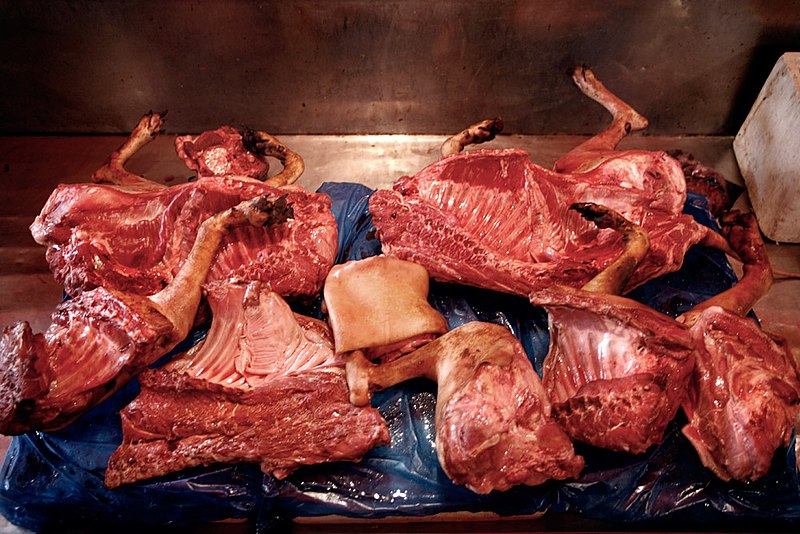In various parts of the world, dog meat has been consumed for centuries, with proponents claiming it to be a delicacy. However, the ethical and health concerns surrounding this practice have sparked intense debates. In this article, we will delve into the taste of dog meat and shed light on the potential risks associated with its consumption.
Dog meat, often likened to a cross between beef and mutton, possesses a distinct flavor profile. It is a red meat, typically quite fatty, and exudes a strong and pungent aroma. The meat is rich in meaty flavor, making it appealing to some palates.
When cooked, dog meat can be identified by its darker color compared to pork. It has a searier texture and oilier fat content than that of hogs. The odor emitted by dog meat is often considered repulsive, setting it apart from other meats.
While we are discussing the taste of dog meat, it is worth mentioning the distinct characteristics of cat meat as well. Cooked cat meat is known for its slightly sour aftertaste, adding a unique flavor dimension. Additionally, little transparent fish-like bones can be found scattered throughout the meat, especially when cooked in a hotpot style.
Despite claims of its nutritional value, dog meat consumption poses significant health risks. One prominent concern is the potential presence of parasitic worms, such as Toxocara canis. Ingesting these worms can lead to severe health complications, including blindness, myocarditis, and respiratory failure.
Another major fear associated with dog meat consumption is the risk of contracting rabies. Dogs, particularly those raised for meat, may carry this deadly virus. Consuming undercooked or raw dog meat can expose individuals to the virus, leading to a potentially fatal infection.
Apart from health concerns, the consumption of dog meat raises ethical questions. In many cultures, dogs are regarded as loyal companions and are even considered members of the family. This emotional bond shared between humans and dogs has led to widespread opposition to the practice of consuming their meat.
Due to the ethical and health concerns, the consumption of dog meat is a highly controversial topic. Animal welfare organizations and activists vehemently advocate against the practice, highlighting the need for stricter regulations and laws to protect these animals.
The taste of dog meat can be described as a fusion of beef and mutton, with a strong, pungent aroma. However, the risks associated with its consumption, including the potential presence of parasitic worms and the risk of contracting rabies, cannot be ignored. Furthermore, the ethical considerations surrounding the consumption of dog meat continue to fuel intense debates.
Ultimately, whether one chooses to consume dog meat or not is a personal decision influenced by cultural, ethical, and health factors. It is crucial, however, to be aware of the potential risks and controversies associated with this practice.

What Does Dog Meat Taste Like?
Dog meat has a distinctive taste that can be described as a combination of beef and mutton. It is a red meat that is generally quite fatty, contributing to its unique flavor profile. The taste of dog meat is often described as having a strong meaty flavor, with some individuals noting that it has a slightly gamey or earthy undertone. Here is a breakdown of the taste characteristics of dog meat:
1. Red meat: Similar to beef or mutton, dog meat has a rich, deep red color that is indicative of its iron content. This contributes to its meaty taste.
2. Fatty: Dog meat tends to be fatty, which adds a layer of richness and succulence to its flavor. The fat content can vary depending on the cut of meat and the cooking method employed.
3. Fragrant: Dog meat has a distinct aroma that can be quite strong and pungent. The fragrance is often described as robust and meaty, intensifying the overall sensory experience.
4. Meaty flavor: Dog meat is known for its intense meaty flavor, which is more pronounced than that of many other meats. It has a certain umami quality, often described as savory and satisfying.
5. Extra meaty flavoring: Compared to more commonly consumed meats like beef or chicken, dog meat has a stronger and more pronounced flavor. This extra meaty flavoring can be attributed to the specific composition and characteristics of dog meat.
It’s important to note that the taste of dog meat may vary depending on factors such as the breed of the dog, the diet it was raised on, and the preparation method used. Cultural and regional variations also play a role in how dog meat is seasoned and cooked, further influencing its taste.
Is Dog Meat Good Or Bad?
Dog meat can be a controversial topic, as opinions and cultural practices vary across different regions. However, it is important to consider the potential health risks associated with consuming dog meat.
1. Nutritional Value: While dog meat may provide some nutrients, it is generally not as nutritious as other meats commonly consumed by humans, such as chicken, beef, or fish.
2. Parasitic Infections: Consumption of dog meat can pose a risk of parasitic infections. Dogs can harbor parasites like Toxocara canis, which can cause serious health issues in humans, including blindness, myocarditis (inflammation of the heart muscle), and respiratory failure.
3. Rabies: Dogs are known carriers of the rabies virus. If the meat is not properly inspected and prepared, there is a risk of contracting this deadly viral disease through consumption.
4. Food Safety Concerns: The conditions under which dogs are raised and slaughtered for meat can vary widely. This lack of regulation and oversight can lead to poor hygiene, improper handling, and the use of contaminated meat, increasing the risk of foodborne illnesses.
5. Ethical Considerations: Many people consider dogs to be companions or pets rather than food animals. The consumption of dog meat can raise ethical concerns and is often viewed as inhumane treatment of animals.
There are several valid reasons to be cautious about consuming dog meat. The potential health risks, including parasitic infections and the transmission of rabies, along with ethical considerations and food safety concerns, make it important to approach the consumption of dog meat with caution.
How Can You Tell If Meat Is Dog Meat?
When determining whether meat is from a dog or another animal, there are several indicators that can help identify it as dog meat. Here are some ways to tell if the meat is from a dog:
1. Appearance: Dog meat tends to have a darker color compared to pork or other meats. It can be easily distinguished by its distinct dark hue, especially in cooked meat.
2. Texture: The muscles of a dog are typically tougher and chewier compared to other meats, such as pork or beef. This seariness can be noticeable when consuming dog meat.
3. Fat content: The fat in dog meat is generally oilier and greasier compared to the fat in pork or other meats. This can be observed when handling or cooking the meat.
4. Odor: The odor of dog meat is often described as repulsive and distinct. It is noticeably different from the smell of pork or other meats. Some people may find the odor of dog meat off-putting.
It is important to note that the consumption of dog meat is considered controversial and illegal in many countries due to cultural, ethical, and animal welfare concerns. If you suspect that the meat you have encountered is dog meat, it is advisable to report it to the appropriate authorities.
Conclusion
Dog meat is a red meat that has a unique taste and aroma. It can be described as a combination of beef and mutton, with an extra meaty flavor. However, it is important to note that consuming dog meat comes with health risks. Parasitic worms, such as Toxocara canis, can be present in dog meat, leading to serious health issues like blindness, myocarditis, and respiratory failure. Additionally, the risk of contracting rabies from infected dogs is a legitimate concern. Furthermore, the texture and appearance of dog meat differ from other meats. It has a darker color compared to pork and distinct muscles that are searier and fat that is oilier than hog fat. The smell of dog meat is often described as repulsive. while dog meat may be consumed in some cultures, it is crucial to be aware of the potential health hazards associated with its consumption.












